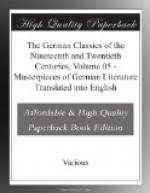A similar impulse toward popularization actuated Arnim and Brentano in their joint work, The Boy’s Magic Horn (1806-8). This is the achievement upon which their greatest fame will always rest. It is one of the best collections of folk-songs and popular ballads in any language, and has been of the greatest influence upon Germany. There was no desire on the part of the editors to write a learned treatise; they simply wished to gather together and record the folk-songs of the Fatherland before they were lost forever. In Arnim’s own words: “The richness of this our national song cannot fail to attract universal attention; it will surprise many; it will supplement many an effort of our own times, or will render such effort needless. We expect a great deal from the joyous happy life in these songs—a manifold, full tone in poetry, an echo of very definite ideas, or an impulse to arouse many a half-forgotten youthful memory. These poems will not only be read, they will be remembered and sung. They embrace in their content, perhaps the greatest portion of German poetry. They will thus set free many an indefinite longing—a something which is not satisfied by much re-reading.”
Goethe greeted the new undertaking with enthusiasm and urged the editors to “keep their poetic archives clean, strict, and in good order.” He, too, urged that “this book should be in every house where joyful humans dwell, by the window, under the mirror, or where song book and cook book lie. There it should remain, ready to be opened, and there something should be found for every varying mood.” While this fate has not been granted the work, it has grown deservedly popular. Philological criticism has caviled at the free hand which Arnim, especially, used in remolding the songs, but the editors are freed of any possible charge of intellectual dishonesty toward reader and source in that their object was to present artistic unities and not material for further study and dissection.




